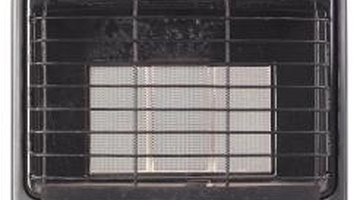The Proper Tubing Size for a 30,000 BTU Natural Gas Heater
Natural gas heaters require a proper fuel line size in order to accommodate the volume of gas required to make the heater run at the proper efficiency level. The size of the fuel conduit, which might be copper tubing, is determined based on both the thickness of the tubing or pipe and the distance the gas must travel through the pipe to get to the heater.
Point of Delivery

The gas pressure at the point of delivery, which is the home or more precisely the gas utility line's terminal at the home, needs to be known before you can precisely determine the size of pipe needed to run a 30,000 BTU natural gas heater at that point. Many heaters come with a connection for 3/8-inch pipe. If the pressure at the point of delivery is too great for this size of pipe, you may need to increase pipe length to accommodate for the increased pressure. Contact a qualified professional to determine your pressure at the delivery point.
Pipe Length
The pipe length is directly proportional to the pressure delivered to the heater at the point of delivery. This pressure is measured in a unit known as water column. The amount of this pressure decreases with the length of pipe. For example, a 3/8-inch pipe of 10 feet will exert water column pressure of 95, while the same diameter of pipe at 80 feet of length would decrease the pressure significantly, to 31.
Appliance Type
The type of appliance you connect to your gas line determines the required gas delivery in cubic feet per hour. Since you will be installing a 30,000 BTU heater, the calculation will be based on that figure. Generally, you can calculate the rough number of cubic feet per hour of natural gas required by dividing the number of BTUs by 1,000. In this case, your heater would need to receive 30 cubic feet of gas per hour to operate properly.
Diameter
The choice in pipe size is based partly on the nominal size of the size of the pipe itself. The nominal size is the exterior diameter the pipe, which in this case is 3/8 inch. This nominal size is closely related to the interior diameter of the pipe also, which helps to determine the amount of pressure the pipe can withstand. The thickness of pipe walls is what withstands this pressure. Increasing the nominal diameter of the pipe reduces the amount of pressure the pipe can withstand because the thickness of the walls is determined in proportion to the outside diameter itself.
Writer Bio
Jared Lewis is a professor of history, philosophy and the humanities. He has taught various courses in these fields since 2001. A former licensed financial adviser, he now works as a writer and has published numerous articles on education and business. He holds a bachelor's degree in history, a master's degree in theology and has completed doctoral work in American history.
Photo Credits
- Hemera Technologies/PhotoObjects.net/Getty Images
More Articles



